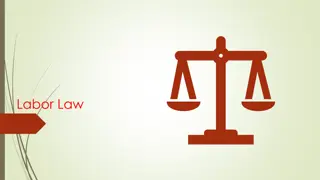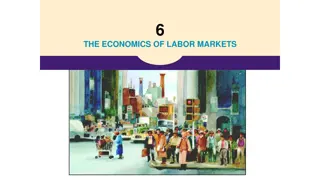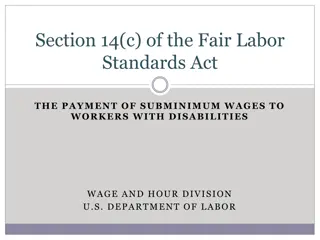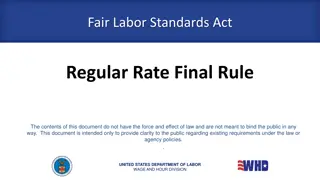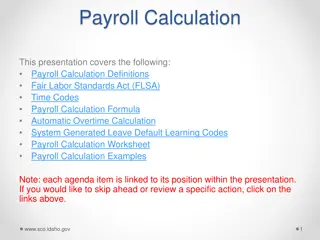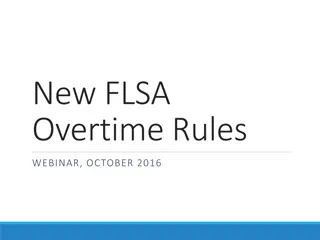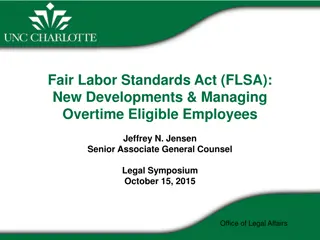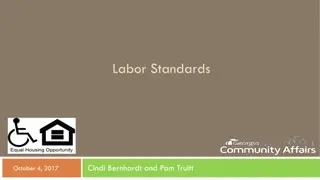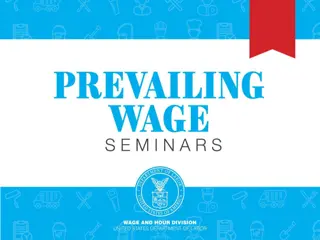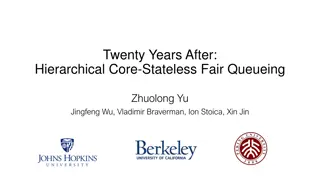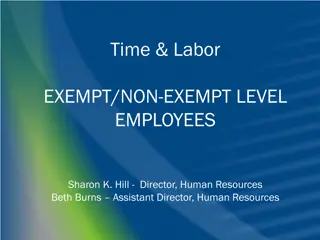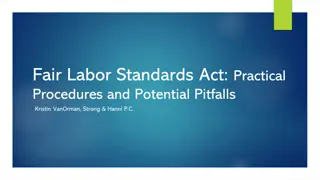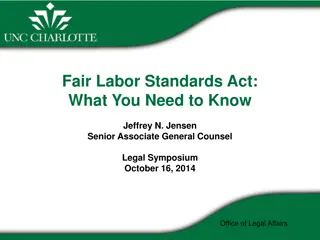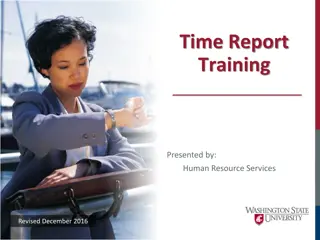FAIR LABOR STANDARDS ACT (FLSA) 2024
The Fair Labor Standards Act (FLSA) of 1938 is a federal wage and hour law that impacts employees' pay and overtime. Learn about the recent changes in the law, including the raised minimum salary threshold and the impact it has on exempt and nonexempt employees. Discover how the FLSA aims to ensure fair pay practices and simplify regulations for both workers and businesses.
Download Presentation

Please find below an Image/Link to download the presentation.
The content on the website is provided AS IS for your information and personal use only. It may not be sold, licensed, or shared on other websites without obtaining consent from the author.If you encounter any issues during the download, it is possible that the publisher has removed the file from their server.
You are allowed to download the files provided on this website for personal or commercial use, subject to the condition that they are used lawfully. All files are the property of their respective owners.
The content on the website is provided AS IS for your information and personal use only. It may not be sold, licensed, or shared on other websites without obtaining consent from the author.
E N D
Presentation Transcript
FAIR LABOR STANDARDS ACT (FLSA) 2024 A N OV E RV I E W
LEARNING OUTCOMES WHAT IS THE FLSA? WHY HAS THE LAW CHANGED? WHAT IS THE IMPACT ON ME? HOW DO I REPORT MY TIME?
WHAT IS THE FLSA? WHY DID IT CHANGE? FLSA 2024
WHAT IS THE FLSA? WHAT IS THE FLSA? The Fair Labor Standards Act of 1938 is the US Department of Labor (DOL) federal wage and hour law. Everyone is covered but some employees are exempt (salaried) and some are nonexempt (hourly). The FLSA requires nonexempt employees be paid overtime (OT) at 1.5x OR compensatory time for all hours worked over 40 in a workweek.
EXEMPT V. NONEXEMPT Exempt Salaried Don t report hours worked Leave accounted for in half-day or full-day increments Not eligible for OT/compensatory time Nonexempt Hourly Report all hours worked Leave accounted for in 15-minute increments Eligible for OT/compensatory time
WHAT HAS CHANGED IN THE LAW? THE US DOL HAS RAISED THE MINIMUM SALARYTEST THRESHOLD. THIS SETS THE SALARY THRESHOLD AT A $844 WEEKLY OR $43,888 ANNUAL SALARY. THE FINAL RULE WAS EFFECTIVE JULY 1, 2024.
THE LAW CHANGED TO Update the overtime regulations to reflect the original intent of the Fair Labor Standards Act. Update Pay Pay workers fairly for the work they perform Simplify and modernize Simplify and modernize the rules so they re easier for workers and businesses to understand and apply
THE IMPACT OF NEW OVERTIME FLSA 2024 RULE
WHO WILL NOT BE AFFECTED WHO WILL NOT BE AFFECTED Faculty and Instructional academic staff whose primary duties are teaching are exempt regardless of salary Teachers, lawyers, and doctors qualify for this professional exemption Existing non-exempt university staff will not be affected.
WHO WILL BE AFFECTED? If an employee s rate of pay is below the new minimum salary level, that employee will be nonexempt unless they qualify for an exemption. Some exempt university staff will become eligible for overtime because their salaries will be below the new threshold. Some non-instructional academic staff will become eligible for overtime because their salaries will be below the new threshold.
SALARY THRESHOLD NOT PRORATED A-Basis. An employee with a 12-month, whose base salary is above the threshold but, because of hours worked, their weekly earnings are below the threshold are nonexempt and eligible for overtime unless a teacher, doctor, or lawyer. E.g. $44,000 base x 0.75 FTE = $33,000 earnings. C-Basis. An employee with a nine-month appointment who makes less than $844 per week during the nine months is below the threshold. This employee is nonexempt. Fluctuating FTE. An employee who works varying percentages over the course of a year becomes nonexempt if their weekly earnings fall below the salary threshold at any point. This employee becomes nonexempt and will record hours biweekly. When the salary is above the threshold, the employee can work with HR to move back to salaried.
Employees newly eligible for overtime will report all hours worked WHAT DO THE FLSA CHANGES MEAN FOR ME? Employees newly eligible for overtime will continue to be paid biweekly. Your employment category will not change. Your leave and benefits earning will not change in amount will continue to earn on a biweekly schedule. Your professional role, your duties, and your place in serving the university s mission will not change.
RECORDING TIME FLSA 2024
TALK TO YOUR SUPERVISOR TALK TO YOUR SUPERVISOR Communication is key!! New policies for OT require you receive prior approval from your VC prior to recording. Clarify expectations of working at home, work hours, and projects that may have been accomplished outside of 40 hrs.
Nonexempt employees are eligible for Overtime (OT) or Compensatory (Comp) time at time-and-one-half (1.5) for all hours worked over 40 in a workweek. Each week is separate for OT purposes. OVERTIME AND COMPENSATORY TIME Hours of paid leave time are not counted towards the 40 for FLSA purposes. Employees may accumulate up to 80 hours of comp time. The institution has the discretion to approve scheduled use of compensatory time. UPS Operational Policy,SYS 1277: Compensation
TIMEKEEPING As a non-exempt employee, you must receive pay for any and all hours worked. Time and leave must be reported in 15-minute increments. Timekeeping must be done on a weekly basis (because overtime/comp time earned in a workweek) Non-exempt employees are paid biweekly For most employees, Time and Labor in HRS will show a blank timesheet for the employee to record shift in/out and break out/in.
HOURS WORKED Log in to your timesheet. Enter the shift in/out and break out/in for unpaid lunch punches. Once the hours are accurate, click submit.
ABSENCE Log in to your timesheet On the row with the absence, select the absence type from the Time/Absence Code drop down Enter the hours requested in the Quantity field. If a partial day absence, click the plus sign next to the date and enter hours worked in the Shift In/Shift Out fields. Once accurate, click submit.
TIME AND ABSENCE HELP TIME AND ABSENCE HELP Time and Absence Help (wisconsin.edu)
BEST PRACTICES/GUIDANCE -Enter your time daily, followed by entering it weekly. -As a safety net, create a bi-weekly calendar reminder to make sure you have entered your time on the timesheet. -After your first pay period, double check your earning statement to ensure it matches your time entered. -Use military time (4:30 pm is 1630) -Round time to the nearest 15-minute increment
SUMMARY The FLSA is a federal law that defines who is eligible for overtime and who is not. The FLSA law changed in order to reflect the original intent of the law, modernize and simplify application, and to pay workers fairly. Employees impacted by these changes now need to record hours worked, are eligible for overtime/comp time, and will be paid on a biweekly basis. Use this PowerPoint and additional resources to record time worked.
RESOURCES UW-Shared Services Time and Absence Help UW-Shared Services Time and Absence Help UW-Stevens Point Payroll Schedule for 2024 UW-Stevens Point Payroll Schedule for 2024 UW-Stevens Point Human Resources: hr@uwsp.edu hr@uwsp.edu Eric Roesler, Chief Human Resources Officer: eroesler@uwsp.edu eroesler@uwsp.edu
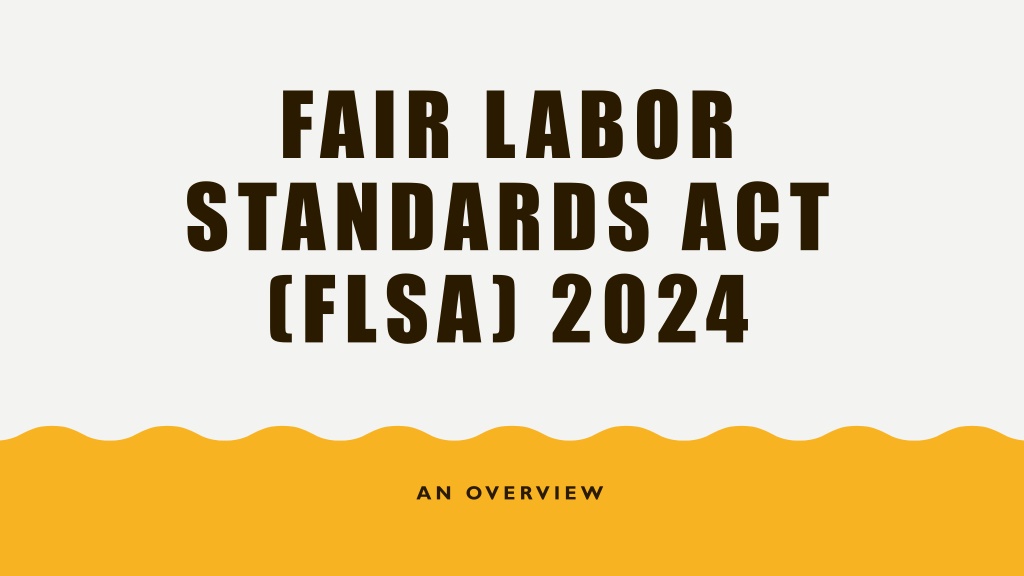
 undefined
undefined












